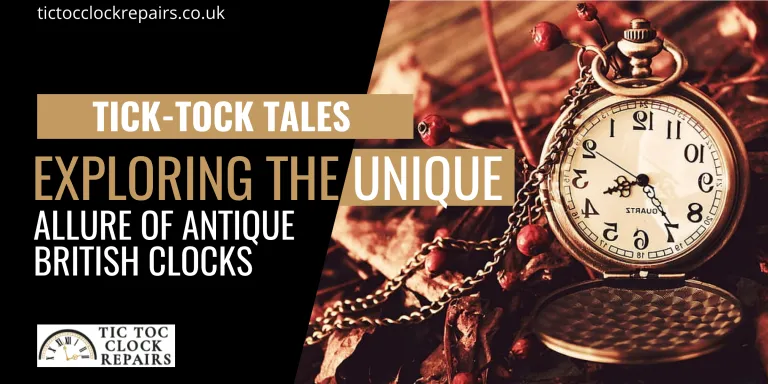Imagine walking into a room where every tick and tock tells a story of history, artistry, and innovation. Each chime echoes the spirit of centuries past as they mark the passing seconds.
That’s the magic you step into when exploring the world of antique British clocks. These aren’t just timepieces; they’re artefacts of Britain’s rich horological heritage, whispering tales from an era where every second counted differently.
Now, picture yourself being swept away on a journey through time, from the earliest sundials and water antique clocks to today’s intricate mechanical marvels. Along this voyage, you’ll encounter some of Britain’s most notable clockmakers who’ve left their indelible mark in this craft.
You’ll come face-to-face with designs that evolved over centuries and learn about their lasting value in today’s antique market. Whether you’re a seasoned collector or simply love history and design, this exploration will reveal why these tick-tock tales continue to captivate us all.
The History of Timekeeping in Britain
Isn’t it fascinating how Britain’s history of timekeeping has shaped our perception of time, transforming simple ticks and tocks into a symphony of seconds?
It’s a tale that dates back centuries, from the primitive sundials used in ancient times to the sophisticated mechanical beautiful clocks that started ticking during the 14th century.
From John Harrison’s marine chronometers aiding seafarers in navigating vast oceans to Edmund Beckett Denison’s design for Big Ben, these innovations are historic milestones and represent Britain’s lasting imprint on horology.
Now, let’s focus on antique British clocks, which belongs to antique bracket clock and collectable clocks – timeless pieces that have endured through the ages, even until the 18th century.
They’re more than mere instruments to track hours and minutes; they’re storytellers narrating tales of craftsmanship, innovation and heritage.
Each tick-tock echoes with tales from the past – stories of master clockmakers working meticulously on their workbenches, shaping gears and assembling intricate mechanisms.
Antique British clocks are a nice day clock and carry an irresistible allure for enthusiasts who appreciate their aesthetic beauty and historical significance.
So next time you stand before an antique British clock and listen to its rhythmic heartbeat, remember you’re not just hearing a measure of passing moments; you’re tuning into a piece of ageless history.
The Artistry Behind Clockmaking
It’s not just about telling time. It’s a testament to the exquisite craftsmanship and dedication that goes into each hand-crafted piece, stirring a sense of awe for the long-forgotten art of clockmaking.
As an admirer of antique British clocks, genuine clocks, you can’t help but marvel at the intricate designs and meticulous attention to detail that these masterpieces exhibit. From ornate engravings on brass dials to the carving precision on wooden casings, every element speaks volumes about the skilful hands behind them.
The artistry in clockmaking extends beyond aesthetics and involves complex engineering principles. Here are some fascinating aspects you might not know:
- The heart of any mechanical clock is its movement or ‘works’, an intricate assembly of gears and springs crafted with extreme precision.
- Some antique British clocks for sale have moon phase indicators that accurately depict lunar cycles – an impressive feat considering they didn’t have modern technology back then with fabulous quality and exceptional quality.
- Many clocks from this era feature fusee chains with original style and personal details—a mechanism designed to help keep time accurate despite changes in stored power.
These facts underline how much thought and effort goes into constructing each piece.
So next time you glance at your antique British clock ticking away silently on the wall, take a moment to appreciate its beauty and the ingenuity and expertise that went into its creation and extensive collection with a great customer reviews in trade customers.
Notable British Clockmakers
Delving into the realm of horology, we discover master artisans who’ve shaped our perception of time, their legacy etched in every meticulously crafted gears and dials that have stood the test of time.
One such name is Thomas Tompion, often called the ‘Father of English Clockmaking’. Born in 1639, Tompion’s work was highly sought after for its precision and quality. His clients included some of England’s most influential figures, like King Charles II and Sir Isaac Newton. He pioneered many advancements in clockmaking, including the cylinder escapement, which was a significant leap forward in accuracy.
Another essential figure worth mentioning is John Harrison, best known for inventing the marine chronometer – a device pivotal to navigation at sea. Born into humble beginnings in 1693, he devised innovative solutions to tackle the longitude determination problem, which baffled sailors for centuries. His H4 model was so successful that it earned him substantial prize money from Britain’s Board of Longitude.
You’ll also find brilliance reflected in George Graham’s works – a genius who brought innovations like deadbeat escapement and mercury pendulum under one roof. These men worked tirelessly to perfect their artistry, each leaving behind an enduring legacy that continues to fascinate us today.
The Evolution of British Clock Designs
Over the centuries, there’s been a remarkable transformation in how timepieces are designed, reflecting not just our evolving tastes but also technological advancements.
In Britain, this evolution has been particularly fascinating. In the early 17th century, lantern clocks with personal details dominated with brass or iron frames and single-hour hands in distinctive styles with intricate details. They were simple yet robust devices that could only be afforded by the wealthy few.
As the centuries rolled on, longcase or ‘grandfather’ clocks became popular; these stately pieces often showcased intricate woodwork and featured both an hour and minute hand.
You’d see another significant shift in design during the Industrial Revolution of the 18th and 19th centuries as mass production techniques made smaller table and mantel clocks affordable to a broader audience. These often sported wooden cases with glass fronts to showcase their precision-engineered movements.
By Queen Victoria’s reign, highly decorative mantle clocks in original style – adorned with various materials like porcelain and marble – had become fashionable status symbols.
By Queen Victoria’s reign, highly decorative mantle clocks in original style – adorned with various materials like porcelain and marble – had become fashionable status symbols.
The Value of Antique Timepieces Today
So, you might be wondering what those old timepieces gathering dust in your attic could be worth today.
Antique British clocks, especially those with unique design elements or ones that hail from a well-known maker, can actually fetch a pretty penny on the market these days. It’s not just about looking pretty on a mantle or wall anymore – these pieces of history often carry significant value.
- Historical significance: This factor always adds to the worth of an antique clock. Suppose it’s been around during essential events or owned by influential figures, its value skyrockets.
- Mint condition: The better preserved the clock, the higher its cost. Original parts and working conditions are vital factors collectors look for.
- Maker’s mark: Just as with fine art, the creator of an antique clock plays a pivotal role in determining its value. Watches created by renowned makers like Thomas Tompion or George Graham are highly sought after.
Remember, selling antique items isn’t merely about getting rid of old stuff; it’s about passing on valuable pieces of history to those who appreciate them. So don’t rush into selling off your grandmother’s mantel clock without doing proper research – you never know what treasure you may have lurking in your attic!



